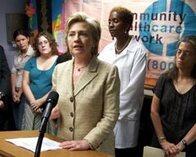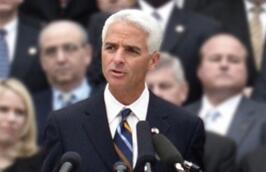Ohio Governor: Strickland Lead 12
Ohio's troubled economy and corruption scandals have given Democratic Congressman Ted Strickland a persistent advantage over Republican Secretary of State Ken Blackwell in the race for Governor here.

Ohio's troubled economy and corruption scandals have given Democratic Congressman Ted Strickland a persistent advantage over Republican Secretary of State Ken Blackwell in the race for Governor here.

The latest Hillary Meter finds that 43% of Americans view the former First Lady as politically liberal. Another 30% say she’s a moderate and 10% see her as conservative.

Republican Governor Jodi Rell now leads the Democratic nominee, New Haven Mayor John DeStefano, 58% to 33%.

Sixty-one percent (61%) of American adults believe that Republican leaders have been “protecting [Mark] Foley for several years.”

Senator Joseph Lieberman (I) has increased his margin over Democrat Ned Lamont by eight points. He now leads the antiwar candidate 50% to 40%.

The latest Rasmussen Reports poll of Ohio's U.S. Senate race shows that Democratic Congressman Sherrod Brown has added a couple more points to a growing lead over Republican Senator Mike DeWine.

Republican Attorney General Charlie Crist has opened up a wide lead over Democratic Congressman Jim Davis. The latest Rasmussen Reports election survey shows Crist ahead 54% to 38%.

Worker Confidence among accounting & finance professionals fell in September, as the group's Hudson Employment Index (SM) declined 6.3 points to 106.2. A significant drop in hiring expectations and job satisfaction contributed to the decline.

After hitting a record high last month, the Hudson Employment Index (SM) for Atlanta fell 2.5 points to 118.6 in September. While perceptions of personal finances faltered, concerns regarding lay offs hit an all time low, tempering the decline.

The Hudson Employment Index (SM) for Boston workers fell 2.1 points to 91.8 in September, its lowest reading of the year. Area confidence has been steadily declining since April when the Index was at 103.7. Less optimism regarding hiring expectations and job satisfaction continued to hinder local confidence.

Worker confidence in California slipped in August, as the state’s Hudson Employment Index (SM) fell 2.4 points to 108.4.

The Hudson Employment Index (SM) for Chicago inched up 0.6 points to 94.5 in September. The monthly reading of local worker confidence is nearly eight points higher than this time last year, when the city’s Index was 86.8.

The Hudson Employment Index (SM) for Dallas workers continued to climb this month, as worker confidence rose 2.2 points to 112.5 in September.

Worker confidence declined in Florida in September, as the state’s Hudson Employment Index ( SM) dropped 7.1 points to 115.2. Declines in hiring plans, job satisfaction and perceived job security contributed to the drop. Despite the decrease, the latest reading tops last September’s 113.2.

Hispanic workers continued to report an upswing in confidence, while African-American worker's confidence fell in September.

Worker Confidence among IT Professionals rebounded in September, as the sector's Hudson Employment Index (SM) rose 6.2 points to 109.3.

Confidence among workers in the legal sector plunged in September, as the sector’s Hudson Employment Index (SM) fell 16.3 points to 97.9.

The Hudson Employment Index (SM) for Los Angeles workers slipped 1.6 points to 100.6 in September .

After recording two consecutive increases, confidence among manufacturing workers plunged in September.

Falling steadily since February of this year, the Hudson Employment Index (SM) for Minneapolis-St. Paul workers reversed its momentum in September as local worker confidence rose 2.8 points to 94.9.